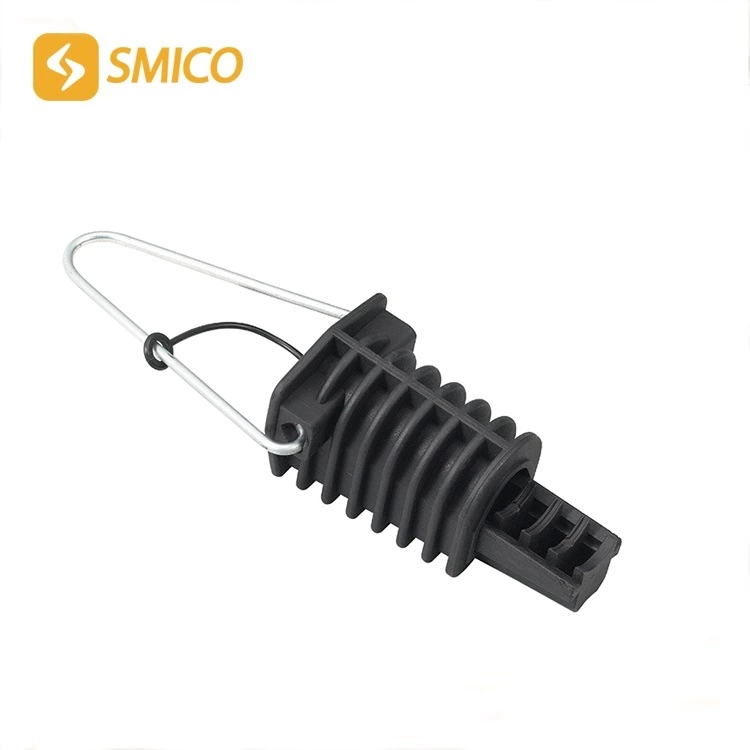Technical Requirements For Wedge-type Tension Clamps In Power Fittings
dead end clamp is used to fix the conductor or lightning conductor to the tension insulator string of the non-linear pole tower, acting as an anchor, and also used to fix the guy wire of the guyed pole tower. ab cable dead end clamp is a hardware that connects the conductor (ground) wire to the tension string (group) or hardware string (group). abc dead end clamp According to the different structures and installation conditions, it can be roughly divided into two categories.
First category: dead end clamp for ab cable To withstand the full tension of the conductor or ground wire, the clamp gripping force is not less than 90% of the rated tensile strength of the installed conductor or ground wire, but it is not used as a conductor. This type of clamp can also be removed after the conductor is installed and used separately. This type of clamp includes bolt type dead end clamp for abc cable and wedge type fungsi dead end clamp, etc.
Second category: clamp dead end In addition to bearing the full tension of the conductor or ground wire, it also serves as a conductor. Therefore, once this type of clamp is installed, it can never be disassembled again, and it is also called a dead wire clamp. Because it is a conductor, the installation of the clamp must comply with the provisions of the relevant installation operating procedures and be carried out carefully.
dead and clamp According to the structure and installation method, it is divided into bolt type dead clamp, compression tension clamp, wedge tension clamp and pre-twisted tension clamp. Bolt type tension clamp is a tension clamp that fixes the conductor with bolts. Compression tension clamp is a tension clamp that fixes the conductor by compression. Wedge tension clamp is a tension clamp that fixes the conductor with a wedge. Pre-twisted tension clamp is a pre-formed spiral strip wrapped around the conductor or ground wire to bear mechanical or electrical loads.
Technical requirements for tension clamps.
(1) The general technical conditions of tension clamps shall comply with the provisions of GB/T 2314-2008 and shall be manufactured according to the approved drawings in accordance with the prescribed procedures.
(2) The connection dimensions of the tension clamp shall ensure that it matches the hardware to which it is connected.
(3) The tension clamp that bears electrical load should not reduce the conductivity of the conductor, and its electrical performance should meet the following requirements:
① The resistance between the two ends of the conductor contact should not be greater than the resistance of the conductor of the same length for the compressive tension clamp; and should not be greater than 1.1 times the resistance of the conductor of the same length for the non-compressive tension clamp.
② The temperature rise at the contact point of the conductor should not be greater than the temperature rise of the connected conductor.
③ The current carrying capacity of the tension clamp should not be less than the current carrying capacity of the installed conductor.
(5) When the curved extension part of the non-compressive tension clamp contacts the conductor and the ground wire under tension, the curvature radius at the exit of the secondary curved extension part should not be less than 8 times the diameter of the installed conductor and the ground wire.
(6) The internal pores of the compression tension clamp should be minimized to prevent moisture from entering during operation.
(7) The connection between the tension clamp and the conductor and the ground wire should avoid the problem of bimetallic corrosion between two different metal parts.
(8) After installation, the tension clamp should be installed to prevent the conductor, ground wire and hardware contact area from being damaged by excessive stress due to breeze vibration, conductor oscillation or other factors.
(9) The tension clamp should avoid stress concentration to prevent excessive metal cold deformation of the conductor and ground wire.
(10) The strength of the non-compression part of the steel anchor pipe of the compression type tension clamp should not be less than 105% of the calculated breaking force of the conductor and ground wire or meet the requirements of the buyer.
(11) The strength of the bolt type tension clamp should not be less than 105% of the calculated breaking force of the conductor or meet the requirements of the demand.
(12) The compression type tension clamp should mark the compression position and compression direction on the outer surface of the pipe.

